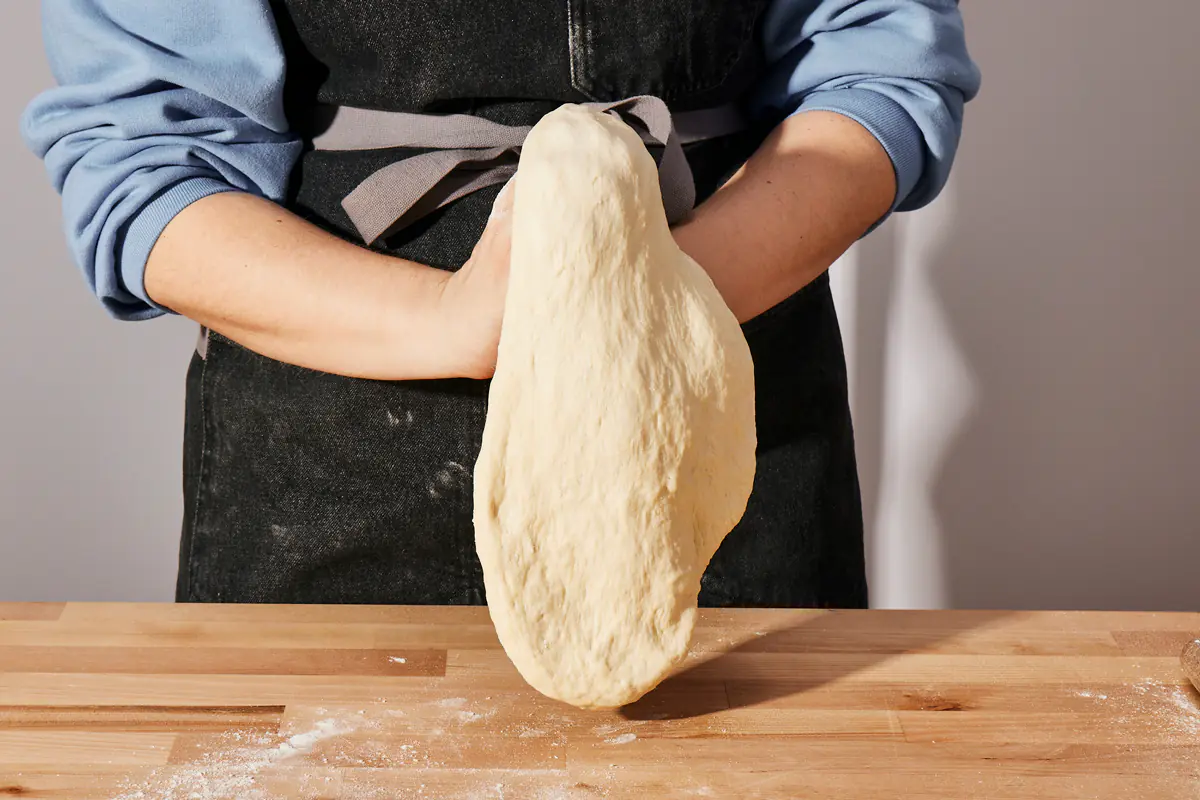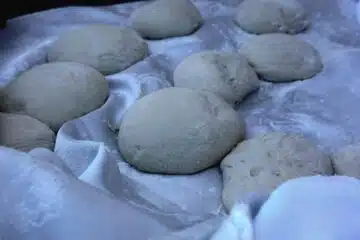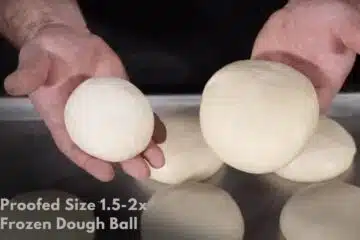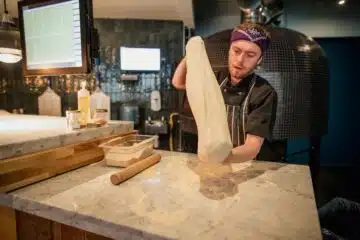To prevent pizza dough from shrinking, allow it to rest properly and roll it out gently. Maintain a consistent thickness to avoid elastic recoil.
Making pizza at home can turn into a disappointing affair when your dough keeps snapping back, shrinking away from that ideal shape you’re aiming for. The secret to perfectly stretched pizza dough lies in understanding the science behind gluten development and fermentation. This knowledge is crucial as it helps you avoid overworking the dough or not giving it enough time to relax, which can cause the gluten to tighten and the dough to shrink during rolling.
Properly resting the dough allows the gluten to relax, making it more pliable and easier to shape. A rested dough also ensures even thickness, contributing to a uniform bake. However, it’s important to note that temperature plays a crucial role as well; dough that’s too cold can retract quickly. Mastering these tips, especially temperature control, will lead to a more stable base for your delicious toppings, bringing you one step closer to pizza perfection.
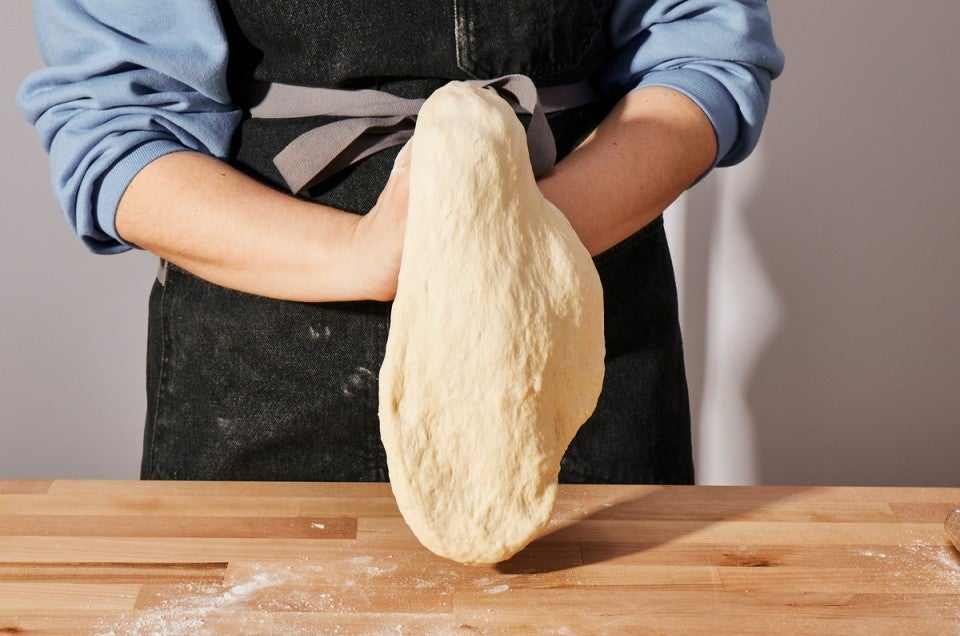
Credit: www.kingarthurbaking.com
The Science Behind Pizza Dough Shrinking
Have you ever watched your pizza dough shrink back as you tried to roll it out? This common frustration has a scientific explanation. Factors like gluten formation and yeast activity play key roles in this culinary challenge. Understanding the science behind it can lead to a better pizza dough that stays put, and this newfound knowledge will make you feel enlightened and more confident in your pizza-making skills.
The Role Of Gluten In Dough Elasticity
Gluten, a protein found in wheat flour, is the backbone of dough elasticity. When flour mixes with water, gluten proteins become interconnected, forming a stretchable network. This enables the dough to stretch without breaking. Here’s how gluten affects dough:
- Water absorption: Gluten absorbs water, becoming elastic.
- Kneading: The more you knead, the stronger the gluten network.
- Resting: Dough must rest to relax the gluten and prevent shrinking.
Rest the dough properly to make it easier to shape. This allows the gluten to relax and reduces the elasticity that causes shrinking.
Yeast Fermentation And Dough Retraction
Yeast is an essential ingredient in pizza dough. It feeds on sugars, releasing gas that helps dough rise. During fermentation:
- Yeast transforms sugars into carbon dioxide and alcohol.
- The gas expands, causing the dough to inflate and become airy.
- Over-fermentation can cause the dough to tighten and retract.
Controlling fermentation time is crucial. Allow the dough to rise until it doubles in size, but no longer. This balance helps prevent the dough from shrinking when rolled out.
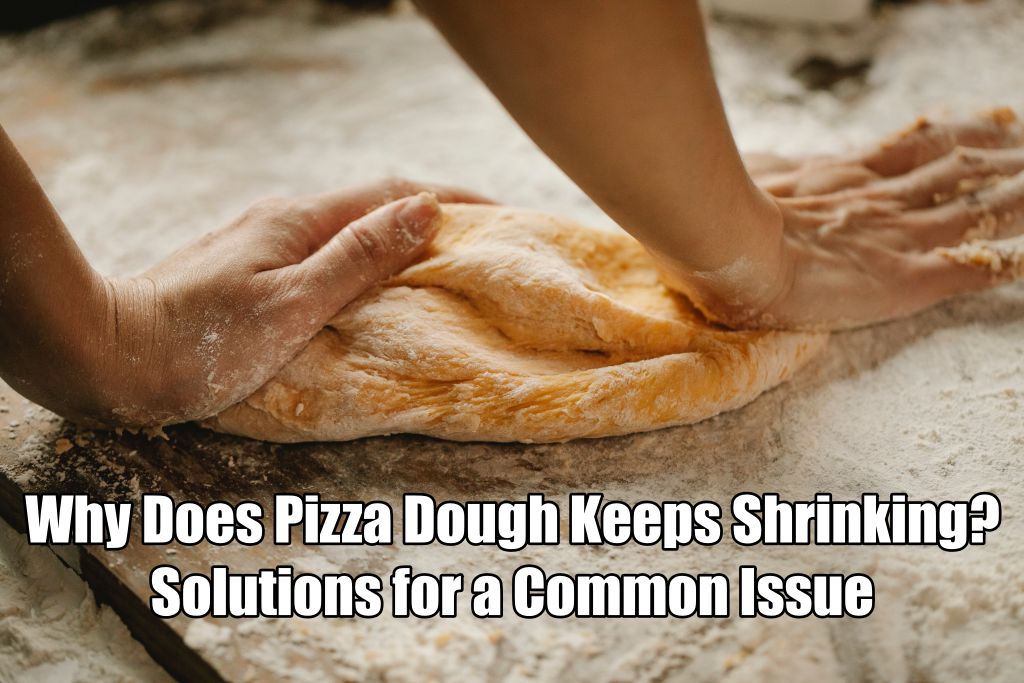
Credit: drystreetpubandpizza.com
Choosing The Right Flour
Have you ever rolled out your pizza dough only to watch it shrink back before your eyes? The secret to preventing this lies in the choice of flour. Different flours can drastically affect your pizza dough’s behavior due to their varying gluten content. Let’s explore what makes flour better suited for your perfect, non-shrink pizza base.
Flour Types And Their Impact On Dough
The foundation of any delicious pizza starts with the dough. This critical base ingredient comes in many varieties. Understanding these will help you create the ideal pizza dough that holds its shape.
- All-purpose flour is versatile and commonly used in households. However, it may only sometimes give the best results for pizza.
- Bread flour has a higher gluten content. This means it can create a stretchier dough that’s less prone to shrinking.
- Whole wheat flour offers a nuttier flavor but can make the dough dense and prone to shrinking.
- 00 flour is finely ground and high in gluten. It’s often used for Neapolitan pizzas and is a great choice for a stretchy, shrink-resistant dough.
Protein Content: A Key Factor
Protein content in flour affects the dough’s elasticity. More protein means more gluten, which is responsible for the dough’s stretchiness. Here’s why protein content matters:
| Flour Type | Protein Content |
| All-purpose flour | 8-11% |
| Bread flour | 12-14% |
| Whole wheat flour | 14-16% |
| 00 flour | 11-13% |
For a dough that keeps its shape better, aim for a higher protein content. Bread flour or 00 flour will often yield the best results.
The Importance Of Dough Temperature
Ever wonder why your pizza dough keeps shrinking? It can be frustrating. The secret to perfect dough lies in controlling its temperature. The right temperature means the dough will stretch easily and stay in place. Let’s learn about the optimal dough temperature for pizza and how to maintain it.
Optimal Dough Temperature
Getting the dough temperature just right is key. The optimal range for pizza dough is usually between 20°C and 26°C (68°F and 78°F). This range allows the gluten in the dough to relax, making the dough flexible but still stable.
A simple way to check the temperature is with a food thermometer. If you don’t have one, touch the dough. It should feel slightly cool, not cold or hot.
- The dough is too stiff if it feels cold.
- If it feels warm, it may become too elastic.
You can adjust the water temperature you use to control the dough temperature. Use warm water in cold conditions and cool water in hot conditions.
Effects Of Hot And Cold Environments
Your kitchen’s temperature can affect your dough. Hot and cold rooms change the dough’s behavior.
| Environment | Effect on Dough | Action to Take |
| Hot Room | The dough rises too quickly. | Use cooler water. |
| Cold Room | The dough rises too slowly. | Use warmer water. |
In a hot environment, the yeast in the dough activates fast, which can cause it to rise too quickly and shrink back. A cold environment slows down yeast activity, which makes the dough rise slowly, which can make it hard to stretch.
- Use a proofing box to keep the temperature steady.
- Let dough rest in a controlled environment.
Kneading Techniques To Prevent Shrinking
Perfecting your pizza dough is both an art and a science. One common issue is the dough shrinking back as you try to stretch it. Kneading techniques can greatly influence this tendency. With the right approach, you can achieve a stable, stretchy dough that holds its shape beautifully. Let’s delve into effective kneading methods to keep your pizza dough from shrinking.
Hand Kneading Vs. Machine Kneading
Kneading by hand allows for a personal touch and control over the dough’s texture. It’s crucial to be gentle and consistent.
Machine kneading, on the other hand, offers convenience and uniformity. However, both methods have their place in dough development.
How Over-kneading Affects Dough
| Method | Impact on Dough |
| Hand Kneading | It can be gentle and encourages texture monitoring. |
| Machine Kneading | Risk of overworking; automate time and speed. |
- Limit kneading to prevent over-elasticity.
- Target a smooth, pliable dough consistency.
- Avoid excessive flour, which can toughen the dough.
Both over-kneading and under-kneading can cause the dough to shrink back. Find the sweet spot, usually just when the dough is smooth and springs back slightly to the touch.
Resting Time: A Critical Step
Making perfect pizza dough feels like a magic trick, but it’s not! Understanding the importance of resting time is key to preventing dough shrinkage. It’s simple: rested dough equals better pizza.
Proper Dough Resting
Give dough the time-out it needs. It’s like a nap for your dough, helping it to perform better and stretch without a fight. Here’s how:
- Shape your dough balls right after mixing for the best rest.
- Place dough in a container with enough space to grow.
- Cover with a damp cloth to keep moisture in.
Letting it rest for at least 30 minutes makes a big difference, but an overnight rest in the fridge brings perfection.
Gluten Relaxation During Rest
Why is gluten-chilling important?
| Gluten Factor | Impact on Dough |
| Tight Gluten | Makes dough snap back like a rubber band. |
| Relaxed Gluten | Let the dough stretch into a perfect circle. |
During rest, gluten proteins unwind and link up more loosely. This means your rolled-out dough stays put without shrinking back.
Rolling Out The Dough: Best Practices
Making pizza at home is a fun experience. The rolling step is crucial. The goal is to get a flat, even, and non-shrinking base. Here are some tips to prevent dough from pulling back. Follow these practices for the best pizza base.
Rolling Techniques To Maintain Shape
Proper rolling techniques ensure a perfect shape. Start in the middle and roll outwards. After a few rolls, turn the dough at 90 degrees. This keeps the shape uniform. Use gentle pressure. Too much force causes shrinking. Let’s look at the right tools next.
Using The Right Tools For Even Thickness
Tools impact the dough’s thickness. A rolling pin is ideal. Choose one that feels comfortable in your hands. It should roll smoothly. A dough mat with circles helps measure size. Silicone or wooden rolling pins are best. They prevent sticking and tearing.
Preventing Dough Retraction During Topping
A stretchy, thin crust stays perfect if you prepare it right.
Let’s stop pizza dough from pulling back when you add the good stuff on top.
Follow these steps for pizza greatness.
Layering Techniques
The magic starts with smart layering.
Begin with a light sauce coat.
It should not be too thick or runny.
Use a spoon or ladle to spread it.
Cover all the dough, but leave the edges clear.
- Spread cheese evenly over the sauce.
- Next, add your meats and veggies.
- Less is more—don’t overload the dough.
Weight Distribution Of Toppings
It’s all about balance.
Toppings should be evenly distributed.
This keeps the dough flat and nice.
| Topping | Amount | Distribution Technique |
| Cheese | Medium | From the center, move outwards |
| Meat | Light | Small pieces scattered |
| Veggies | Varies | Distribute evenly, no piles |
Baking Tips To Solidify Pizza Shape
Have you ever opened the oven to find your pizza dough has shrunk back to a mini-sized disappointment? Fear not! Solidifying your pizza shape is an art that hinges on technique and precision. Ready to put an end to pizza dough shrinkage? Let’s dive into some crucial baking tips.
Oven Temperature And Pizza Stone Usage
The right oven temperature sets the foundation for a perfectly shaped pizza. Too hot, and your dough will puff and shrink; too cool, and it won’t set properly. Aim for a sweet spot of 475-500°F (246-260°C) for a home oven. This high heat ensures rapid crust formation, locking in the shape.
- Preheat your oven with the pizza stone inside. This mimics a brick oven environment.
- A pizza stone should heat for at least 30 minutes before sliding your dough onto it.
- Consider investing in a thermometer to check the stone’s surface temperature.
Baking Duration And Its Effects
Timing is just as important as temperature. Depending on your oven’s efficacy, bake your pizza for 7-10 minutes. This duration is optimal for most home ovens.
| Baking Time | Effect on Pizza Shape |
| Under 7 minutes | Dough may not set, leading to shrinkage. |
| 7-10 minutes | Perfect for most pizzas, it holds the shape well. |
| Over 10 minutes | Risks overcooking, which could make the crust too hard. |
It must be quick out of the oven. Use a pizza peel to remove it swiftly. Let it cool on a wire rack to avoid sogginess from steam.
Solutions For Common Pizza Dough Issues
Nothing beats the aroma of fresh pizza dough turning golden in the oven. Yet, bakers often need help with common issues like shrinking, stickiness, or hardness. Let’s knead through these problems together.
Dealing With Sticky Dough
Are you struggling with sticky pizza dough? It’s a common issue, but fear not! There are simple fixes to achieve that perfect, non-stick consistency.
- Flour Your Surface: Ensure your work area and rolling pin have a generous coating of flour.
- Use Cold Water: Mixing dough with cold water can reduce stickiness.
- Rest the Dough: Allow your dough to rest. Gluten relaxes, reducing tackiness.
- Control Humidity: Work in a less humid environment or adjust your recipe accordingly.
Remedies For Tough Dough
Is hard pizza dough making your pizza less enjoyable? Transform it with these tweaks:
| Problem | Solution |
| Overworked Dough | Handle the dough gently and for less time. |
| Low Hydration | Increase water slightly for a softer dough. |
| Old Yeast | Ensure your yeast is fresh for better rise and texture. |
| Insufficient Proofing | Give the dough adequate time to rise until it is doubled. |

Credit: www.cookist.com
Frequently Asked Questions
Why Does My Pizza Dough Keep Springing Back?
Your pizza dough springs back because the gluten hasn’t relaxed. Let it rest before stretching to allow the gluten to relax.
How Do You Get Pizza Dough To Stretch?
To stretch pizza dough, start with warm, rested dough. Dust your work surface with flour, then gently press and stretch the dough from the center outwards, rotating frequently to maintain an even thickness. Use your hands or a rolling pin as needed.
Is It Better To Roll Or Stretch Pizza Dough?
Rolling pizza dough can make it tough; stretching by hand is better for a lighter, airier crust. Use gentle hand stretching techniques for the best texture.
How Do You Keep Pizza Dough From Expanding?
To prevent pizza dough from expanding, use less yeast, store the dough in a cool place after kneading, and avoid over-proofing by keeping an eye on the rise time. Also, refrigerate or freeze if not using immediately, and pierce the dough with a fork before baking to release air.
Conclusion
Mastering the art of perfect pizza dough takes patience and practice. By following our tips, you’ll keep that dough from shrinking back. Remember, temperature, technique, and timing are your trusted allies in the pizza-making journey. So, get ready to roll out the dough like a pro and impress with your culinary creations.
Happy pizza crafting!

As the author of the “Ultimate Pizza Guide: Recipes, Tips & Secrets Revealed,” I’m dedicated to sharing my love for pizza and empowering others to create delicious homemade pizzas with ease. Join me on a journey to uncover the secrets to perfecting your pizza game!
